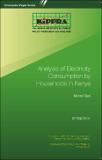| dc.description.abstract | An estimated 1.3 billion people around the world lack access to electricity, with
majority of them living in Sub-Saharan Africa, where two out of every three
households stay in darkness after sunset. In Kenya, according to the Draft
National Energy Policy 2014, the overall electrification rate is approximated at
28.9 per cent, despite recent government efforts to rapidly increase electrification
rates in both urban and rural areas. Similarly, electricity access in rural areas
is approximately 5 per cent, and 51 per cent in urban areas. The continued use of
solid biomass and kerosene contributes to household air pollution, which leads
to respiratory illnesses that are a major health burden.
The main objective of this study is to estimate the amount of electricity consumed
by households with a view to determining the factors that explain the differences
in the levels of consumption and expenditure on electricity. The study uses crosssectional
data of 3,339 households in Kenya. I an attempt to undertake household
expenditure analysis of energy services - mainly biomass and electricity - the
study also uses the Tobit model. Data was obtained from the KIPPRA National
Energy Survey of 2009 and analyzed using the Tobit and the Probit model. | en |

